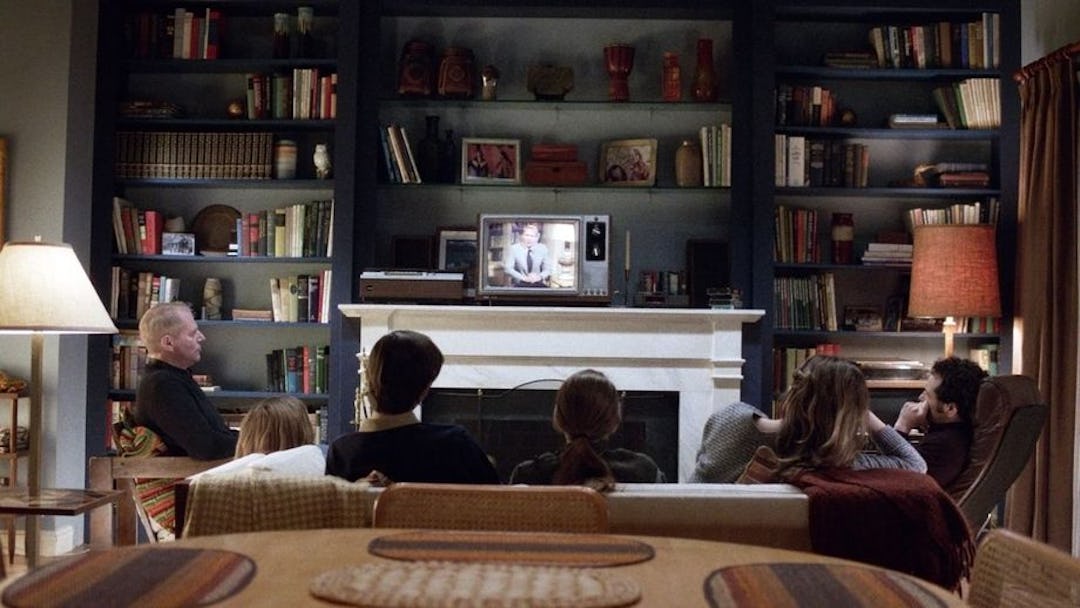Last night’s episode of The Americans, “The Day After,” took a page straight from the Mad Men playbook, using a significant event in pop culture to take the temperature of its characters. The episode borrows its name from a film that aired on ABC on Sunday, November 20, 1983 and is to this day the highest-rated TV movie of all time. When the Jennings family sits down to watch the film, they’re confronted with the catastrophic possibility of nuclear war.
A sense of eeriness pervades “The Day After,” an atmosphere of calm before a storm. Last week, sensing that the couple were reaching a breaking point, Gabriel gave Philip and Elizabeth a “vacation” of sorts; now, it’s been seven months since they took on anything new. The episode doesn’t announce the made-for-TV-film; we don’t hear anyone discussing it before we cut to the Jennings’s living room, where the family has gathered, along with Stan and his son, Matthew, to watch The Day After. We hear actor John Cullum deliver a disclaimer: “Before the movie begins, I would like to caution parents about the graphic depiction of nuclear explosions and their devastating effects. The emotional impact of these scenes may be unusually disturbing.” In a line that highlights the gulf between American- and Soviet-style parenting, Cullum recommends that parents watch with their children so they can be “on hand to answer questions raised” by the movie.
When The Day After aired in real life, it capped off a tense autumn during which the threat of nuclear war seemed more imminent than ever. More than 100 million Americans tuned into ABC to watch the two-hour film, which depicts a nuclear missile attack as it unfolds in Lawrence, Kansas; director Nicholas Meyer cast then-unknown actors like JoBeth Williams and Steve Guttenberg, among others, in an attempt to heighten the film’s realism.
In a sequence that recalls “Babylon,” the Season 7 Mad Men episode centred on the 1969 moon landing, The Americans shows its characters glued to their TV screens in terror and awe. We don’t just see the Jennings’ and the Beemans watching The Day After; we also see Young-Hee and her husband, William the lonely KGB biochemical expert, Oleg and Tatiana from the Soviet Embassy, and their boss, Arkady Ivanovich — and they all look absolutely freaked out.
The whole sequence is silent except for the sounds of the film. As the onscreen attack escalates — chaos in the streets, crowds of people rushing to safety, a giant orange mushroom cloud — the camera starts to zoom in closer on the individual faces of Stan, Elizabeth, Philip, and Paige, in between tighter and tighter shots of the chaos and carnage on the TV screen.
Similarly, in “Babylon,” a near-wordless sequence depicts different sets of characters watching the 1969 moon landing on TV. We hear the hiss of the TV, see the blue light reflected off faces transfixed by technological progress. While the moon landing inspires more wonder than terror, it still freaks people out; when Armstrong officially plants his feet on the moon, Harry Crane stands up, a look of complete horror on his face. Like The Day After, the moon landing brings disparate groups of people together: Everyone’s watching, together, at the same time — Bert Cooper, the symbol of the wealthy, old-guard elite, watches with his black maid.
After the movie airs, Philip and Elizabeth are clearly rattled. (ABC anticipated this kind of reaction, and set up a 1-800 “panic hotline” to take calls after the broadcast; they also aired a panel discussion on nuclear war immediately following the film, featuring Henry Kissinger, Elie Weisel, Brent Scowcroft, Robert McNamara, Carl Sagan and William F. Buckley Jr.) The film has convinced Philip that they should go along with William’s plan to withhold information about a particularly deadly new strain of virus that he’s been developing: “It liquefies your organs,” Philip says. But it has the opposite effect on Elizabeth. “We can’t just sit in our comfortable house and pretend,” she insists. “This is why we’re here.” When Paige confronts Philip, he basically tells her the same thing, despite his own reservations.
Philip isn’t the only one considering the advantages of disobeying orders. Lying in bed post-coitus, Oleg tells Tatiana about some information he received from his father — in September, a Russian launch detection system mistook some sunlight reflecting off clouds for a series of missiles launched from within the United States. Protocol dictates that the person manning the system report the activity, but the man on duty thought something was off, so he didn’t. That incident really did happen, on September 26, 1983 — the man who failed to report the “missiles,” Stanislav Petrov, became known as “The Man Who Saved the World.” “I keep wondering,” Oleg muses, “what I’d done if that were me.”
It’s fitting that an episode that has several characters questioning the wisdom of their commanders also shows how utterly terrified everyone is by the threat of nuclear war. The TV movie brings disparate people together, but only in the sense that it leaves them all feeling panicked and alone — and more unsure than ever of their long-term plans. “The Day After” evokes a dystopian scenario in which the forces keeping global destruction at bay have failed, and each person is left to wonder if he’ll need to be the one to save the world.
